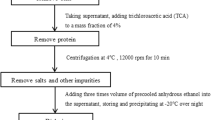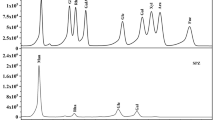Abstract
Twelve Lactobacillus strains isolated from sorghum distillery residue (SDR) pickled cabbage were studied for their in vitro scavenging activity against hydroxyl radicals and DPPH free radicals, inhibition of lipid peroxidation, and their resistance to hydrogen peroxide in cell lysate or intact cells. Lactobacillus brevis D7, at a dose of 1010 CFU/mL, showed the highest hydroxyl radical and DPPH scavenging activities, as well as total antioxidative activity, with inhibition rates of 51.2, 44.9, and 65.2%, respectively in intact cells. On the other hand, the L. brevis D7 strain was the most resistant against hydrogen peroxide. L. brevis D7 isolated from SDR pickled cabbage should be considered as a potential antioxidant to be used in functional foods. Correlation analysis showed that DPPH free radical scavenging activity is a potential screening indicator for high exopolysaccharide (EPS) producing Lactobacillus species.
Similar content being viewed by others
References
Afonso V, Champy R, Mitrovic D, Collin P, Lomri A. Reactive oxygen species and superoxide dismutases: Role in joint diseases. Joint Bone Spine 74: 324–329 (2007)
Luo D, Fang B. Structural identification of ginseng polysaccharides and testing of their antioxidant activities. Carbohyd. Polym. 72: 376–381 (2008)
Stecchini ML, Torre MD, Munari M. Determination of peroxy radical scavenging of lactic acid bacteria. Int. J. Food Microbiol. 64: 183–188 (2001)
Ito M, Ohishi K, Yoshida Y, Yokoi W, Sawada H. Antioxidative effects of lactic acid bacteria on the colonic mucosa of ironoverloaded mice. J. Agr. Food Chem. 51: 4456–4460 (2003)
Kim SE, Kim YH, Lee H, Kim DO, Kim HY. Probiotic properties of lactic acid bacteria isolated from Mukeunji, a long-term ripened kimchi. Food Sci. Biotechnol. 21: 1135–1140 (2012)
Ahire JJ, Mokashe NU, Patil HJ, Chaudhari BL. Antioxidative potential of folate producing probiotic Lactobacillus helveticus CD6. J. Food Sci. Technol. 50: 26–34 (2013)
Hassan AN. Possibilities and challenges of exopolysaccharideproducing lactic cultures in dairy foods. J. Dairy Sci. 91: 1282–1298 (2008)
Ruas-Madiedo P, Hugenholtz J, Zoon P. An overview of the functionality of exopolysaccharides produced by lactic acid bacteria. Int. Dairy J. 12: 163–171 (2002)
Gorska S, Jachymek W, Rybka J, Strus M, Heczko PB, Gamian A. Structural and immunochemical studies of neutral exopolysaccharide produced by Lactobacillus johnsonii 142. Carbohyd. Res. 345: 108–114 (2010)
Pan D, Mei X. Antioxidant activity of an exopolysaccharide purified from Lactococcus lactis subsp. lactis 12. Carbohyd. Polym. 80: 908–914 (2010)
Nichols GM, Bowman JP, Guezennec J. Effects of incubation temperature on growth and production of exopolysaccharides by an antarctic sea ice bacterium grown in batch culture. Appl. Environ. Microbiol. 71: 3519–3523 (2005)
Vaningelgem F, Zamfir M, Adriany T, De Vuyst L. Fermentation conditions affecting the bacterial growth and exopolysaccharide production by Streptococcus thermophilus ST 111 in milk-based medium. J. Appl. Microbiol. 97:1257–1273. (2004)
Celik GY, Aslim B, Beyatli Y. Characterization and production of the exopolysaccharide (EPS) from Pseudomonas aeruginosa G1 and Pseudomonas putida G12 strains. Carbohyd. Polym. 73: 178–182. (2008)
Degeest B, De Vuyst L. Indication that the nitrogen source influences both amount and size of exopolysaccharides produced by Streptococcus thermophilus LY03 and modelling of the bacterial growth and exopolysaccharide production in a complex medium. Appl. Environ. Microbiol. 65: 2863–2870. (1999)
Cerning J, Bouillanne C, Landon M, Desmazeaud M. Isolation and characterization of exopolysaccharides from slime-forming mesophilic lactic acid bacteria. J. Dairy Sci. 75: 692–699 (1992)
Dubois M, Gilles KA, Hamilton JK, Rebers PA, Smith F. Colorimetric method for determination of sugars and related substances. Anal. Chem. 28: 350–356 (1956)
Lowry OH, Rosenbrough NJ, Farr AL, Randall RJ. Protein measurement with the folin phenol reagent. J. Biol. Chem. 193: 265–275 (1951)
Buchmeier N, Bossie S, Chen CY, Fang FC, Guiney D, Libby S. SlyA, a transcriptional regulator of Salmonella typhimurium, is required for resistance to oxidative stress and is expressed in the intracellular environment of macrophages. Infect. Immun. 65: 3725–3730 (1997)
He ZS, Luo H, Cao CH, Cui ZW. Photometric determination of hydroxyl free radical in Fenton system by brilliant green. Am. J. Chinese Clin. Med. 6: 236–237 (2004)
Kao T, Chen B. Functional components in soybean cake and their effects on antioxidant activity. J. Agr. Food Chem. 54: 7544–7555 (2006)
Mitsuda H, Yuasumoto K, Iwami K. Antioxidation action of indole compounds during the autoxidation of linoleic acid. Eiyo to Shokuryo 19: 210–214 (1996)
Wang L, Weller CL, Schlegel VL, Carr TP, Cuppett SL. Supercritical CO2 extraction of lipids from grain sorghum dried distillers grains with solubles. Bioresource Technol. 99: 1373–1382 (2008)
Gamar L, Blondeau K, Simonet JM. Physiological approach to extracellular polysaccharide production by Lactobacillus rhamnosus strain C83. J. Appl. Microbiol. 83: 281–287 (1997)
De Vuyst L, Vanderveken F, Van de Ven S, Degeest B. Production and isolation of exopolysaccharides from Streptococcus thermophilus grown in milk medium and evidence for their growth associated biosynthesis. J. Appl. Microbiol. 84: 1059–1068. (1998)
Deutsch JC. Ascorbic acid oxidation by hydrogen peroxide. Anal. Biochem. 255: 1–7 (1998)
Imlay JA, Linn S. Bimodel pattern of killing if DNA repair defective of antioxically grown Escherichia coli by hydrogen peroxide. J. Bacteriol. 166: 519–527 (1986)
Kullisaar T, Zilmer M, Mikelsaar M, Vihalemm T, Annuk H, Kairane C, Kilk A. Two antioxidative lactobacilli strains as promising probiotics. Int. J. Food Microbiol. 72: 215–224 (2002)
Lin MY, Chang, FJ. Antioxidative effect of intestinal bacteria Bifidobacterium longum ATCC 15708 and Lactobacillus acidophilus ATCC 4356. Dig. Dis. Sci. 45: 1617–1622 (2000)
Namiki M. Antioxidants/antimutagenes in food. Crit. Rev. Food Sci. Nutr. 29: 273–300 (1990)
Amanatidou A, Smid, EJ, Bennik MHJ, Gorris LGM. Antioxidative properties of Lactobacillus sake upon exposure to elevated oxygen concentrations. FEMS Microbiol. Lett. 203: 87–94 (2001)
Aruoma OI. Free radicals, oxidative stress, and antioxidants in human health and disease. J. Am. Oil Chem. Soc. 75: 199–212 (1998)
Author information
Authors and Affiliations
Corresponding author
Rights and permissions
About this article
Cite this article
Lai, YJ., Tsai, SH. & Lee, MY. Isolation of exopolysaccharide producing Lactobacillus strains from sorghum distillery residues pickled cabbage and their antioxidant properties. Food Sci Biotechnol 23, 1231–1236 (2014). https://doi.org/10.1007/s10068-014-0168-3
Received:
Revised:
Accepted:
Published:
Issue Date:
DOI: https://doi.org/10.1007/s10068-014-0168-3




